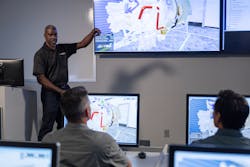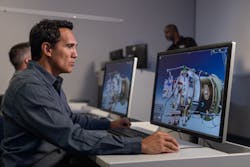FSI Rolls Out Virtual Engine Training
Beyond the basics has always been the guiding principle of FlightSafety International’s maintenance technician training. It’s the difference between providing “good enough” training and allowing technicians to be the best of the best.
This cutting-edge technology improves efficiency, allows for practical instruction for all technicians, in an immersive, thorough training environment. Students benefit in ways beyond what traditional instruction can deliver.
Working With Pratt & Whitney Canada
For more than a decade FlightSafety International (FSI) has been a partner with P&WC, supporting P&WC Engine training programs and developing curriculum for technicians at FlightSafety Learning Centers. This deep relationship and collaboration perfect simulation of real-world operator scenarios, enhancing the training experience while ensuring currency with in-production build specs. As engines evolve, so do the Virtual Engine Trainer models.
The development team took cues from advanced, computer-based technology – similar to what someone might experience with next-generation virtual or augmented reality. In the same way that video game players have been able to manipulate items within the game on multiple axes, the Virtual Engine Trainer (VET) allows instructors and students to view the engine and the many individual components in any position or system grouping, in 3D and complete clarity.
A Better Training Experience
Physical engines are heavy with difficult-to-move components. Using VETs, technicians have access to a degree of interactivity that isn’t possible with physical units. With these new methods, technicians gain a precise familiarity through interactive engine cutaways, seeing how the components and gearing work together.
This new technology allows students to conduct practical maintenance procedures such as part replacement, X-ray and move functionality, further enabling students to view dynamic cross-sections of nearly every engine part.
A New Way to Test and Inspect
Technicians have a great advantage using the VET technology with inspections. The VET allows techs and trainers to simulate an engine inspection during borescope training. They can be virtually altered to represent irregularities found in a turbine engine, with a variety of scenarios or degrees of damage possible to simulate. Technicians are challenged to assess the damage and are evaluated based on engine health and dispatchability. With traditional physical engine trainers, the possibilities are limited and cost-prohibitive to reproduce.
It is a similar concept as in FlightSafety’s simulator training for pilots where potentially hazardous scenarios can be safely simulated for pilots to hone their skills. With the virtual borescope training, technicians get more examples of many more types of damage, or the signs of wear and tear, than they could on a physical component. Most physical models are present only as ideal-state engines, depriving technicians of what they’re likely to experience in real-world scenarios on the line.
The VET technology is so advanced that some regulatory agencies are allowing it as an assessment method for up to 50 percent of practical engine training. This tool allows students to meet requirements more quickly and efficiently, thereby enhancing the value of the training provided.
Like many FlightSafety programs, it is available in a variety of Learning Centers and locations, including the United States, Australia, Brazil, Canada, China, France, and India. The rollout currently covers courses on the PT6, PT6A, PT6E, PT6C, PT6T, PW206, PW300 and PW800 series.
FlightSafety has been preparing technicians for years to meet the challenges of the corporate aviation industry. This cutting-edge program is another instance of FlightSafety empowering these skilled workers with the practical and strategic knowledge needed to further career development and achieve their professional goals.


